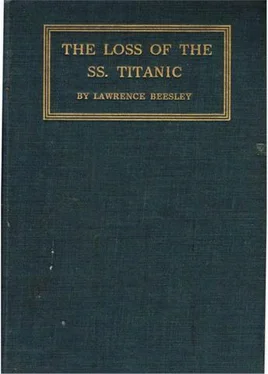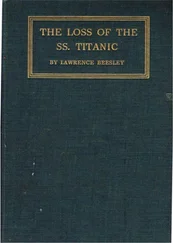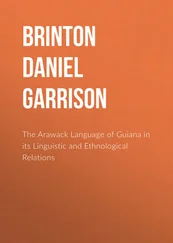It is not easy at this time to call to mind who were in the boat, because in the night it was not possible to see more than a few feet away, and when dawn came we had eyes only for the rescue ship and the icebergs; but so far as my memory serves the list was as follows: no first-class passengers; three women, one baby, two men from the second cabin; and the other passengers steerage—mostly women; a total of about 35 passengers. The rest, about 25 (and possibly more), were crew and stokers. Near to me all night was a group of three Swedish girls, warmly clad, standing close together to keep warm, and very silent; indeed there was very little talking at any time.
One conversation took place that is, I think, worth repeating: one more proof that the world after all is a small place. The ten months’ old baby which was handed down at the last moment was received by a lady next to me—the same who shared her wraps and coats. The mother had found a place in the middle and was too tightly packed to come through to the child, and so it slept contentedly for about an hour in a stranger’s arms; it then began to cry and the temporary nurse said: “Will you feel down and see if the baby’s feet are out of the blanket! I don’t know much about babies but I think their feet must be kept warm.” Wriggling down as well as I could, I found its toes exposed to the air and wrapped them well up, when it ceased crying at once: it was evidently a successful diagnosis! Having recognized the lady by her voice,—it was much too dark to see faces,—as one of my vis-à-vis at the purser’s table, I said,—“Surely you are Miss———?” “Yes,” she replied, “and you must be Mr. Beesley; how curious we should find ourselves in the same boat!” Remembering that she had joined the boat at Queenstown, I said, “Do you know Clonmel? a letter from a great friend of mine who is staying there at——— [giving the address] came aboard at Queenstown.” “Yes, it is my home: and I was dining at———just before I came away.” It seemed that she knew my friend, too; and we agreed that of all places in the world to recognize mutual friends, a crowded lifeboat afloat in mid-ocean at 2 A.M. twelve hundred miles from our destination was one of the most unexpected.
And all the time, as we watched, the Titanic sank lower and lower by the head and the angle became wider and wider as the stern porthole lights lifted and the bow lights sank, and it was evident she was not to stay afloat much longer. The captain-stoker now told the oarsmen to row away as hard as they could. Two reasons seemed to make this a wise decision: one that as she sank she would create such a wave of suction that boats, if not sucked under by being too near, would be in danger of being swamped by the wave her sinking would create—and we all knew our boat was in no condition to ride big waves, crowded as it was and manned with untrained oarsmen. The second was that an explosion might result from the water getting to the boilers, and dèbris might fall within a wide radius. And yet, as it turned out, neither of these things happened.
At about 2.15 A.M. I think we were any distance from a mile to two miles away. It is difficult for a landsman to calculate distance at sea but we had been afloat an hour and a half, the boat was heavily loaded, the oarsmen unskilled, and our course erratic: following now one light and now another, sometimes a star and sometimes a light from a port lifeboat which had turned away from the Titanic in the opposite direction and lay almost on our horizon; and so we could not have gone very far away.
About this time, the water had crept up almost to her sidelight and the captain’s bridge, and it seemed a question only of minutes before she sank. The oarsmen lay on their oars, and all in the lifeboat were motionless as we watched her in absolute silence—save some who would not look and buried their heads on each others’ shoulders. The lights still shone with the same brilliance, but not so many of them: many were now below the surface. I have often wondered since whether they continued to light up the cabins when the portholes were under water; they may have done so.
And then, as we gazed awe-struck, she tilted slowly up, revolving apparently about a centre of gravity just astern of amidships, until she attained a vertically upright position; and there she remained—motionless! As she swung up, her lights, which had shone without a flicker all night, went out suddenly, came on again for a single flash, then went out altogether. And as they did so, there came a noise which many people, wrongly I think, have described as an explosion; it has always seemed to me that it was nothing but the engines and machinery coming loose from their bolts and bearings, and falling through the compartments, smashing everything in their way. It was partly a roar, partly a groan, partly a rattle, and partly a smash, and it was not a sudden roar as an explosion would be: it went on successively for some seconds, possibly fifteen to twenty, as the heavy machinery dropped down to the bottom (now the bows) of the ship: I suppose it fell through the end and sank first, before the ship. But it was a noise no one had heard before, and no one wishes to hear again: it was stupefying, stupendous, as it came to us along the water. It was as if all the heavy things one could think of had been thrown downstairs from the top of a house, smashing each other and the stairs and everything in the way. Several apparently authentic accounts have been given, in which definite stories of explosions have been related—in some cases even with wreckage blown up and the ship broken in two; but I think such accounts will not stand close analysis. In the first place the fires had been withdrawn and the steam allowed to escape some time before she sank, and the possibility of explosion from this cause seems very remote. Then, as just related, the noise was not sudden and definite, but prolonged—more like the roll and crash of thunder. The probability of the noise being caused by engines falling down will be seen by referring to Figure 2, page 116, where the engines are placed in compartments 3, 4, and 5. As the Titanic tilted up they would almost certainly fall loose from their bed and plunge down through the other compartments.
No phenomenon like that pictured in some American and English papers occurred—that of the ship breaking in two, and the two ends being raised above the surface. I saw these drawings in preparation on board the Carpathia, and said at the time that they bore no resemblance to what actually happened.
When the noise was over the Titanic was still upright like a column: we could see her now only as the stern and some 150 feet of her stood outlined against the star-specked sky, looming black in the darkness, and in this position she continued for some minutes—I think as much as five minutes, but it may have been less. Then, first sinking back a little at the stern, I thought, she slid slowly forwards through the water and dived slantingly down; the sea closed over her and we had seen the last of the beautiful ship on which we had embarked four days before at Southampton.
And in place of the ship on which all our interest had been concentrated for so long and towards which we looked most of the time because it was still the only object on the sea which was a fixed point to us—in place of the Titanic, we had the level sea now stretching in an unbroken expanse to the horizon: heaving gently just as before, with no indication on the surface that the waves had just closed over the most wonderful vessel ever built by man’s hand; the stars looked down just the same and the air was just as bitterly cold.
There seemed a great sense of loneliness when we were left on the sea in a small boat without the Titanic: not that we were uncomfortable (except for the cold) nor in danger: we did not think we were either, but the Titanic was no longer there.
Читать дальше












